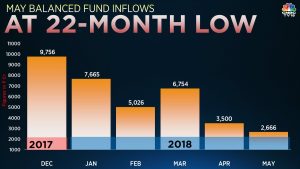How does debt fund’s maturity roll-down help manage market risk
Summary
The difference between equity and bonds is that in bonds there is a maturity date, and with the passage of time, the residual period to maturity comes down. This is known as maturity roll-down as the remaining maturity period is rolling down.
When we say passive fund management, we normally refer to index funds, which mimic a given index such as Nifty or Sensex. However, the index itself can be volatile and the fund, even though there is no active fund manager intervention, can be as volatile.
There is another kind of passive fund management in fixed income funds. The difference between equity and bonds is that in bonds there is a maturity date, and with the passage of time, the residual period to maturity comes down. This is known as maturity roll-down as the remaining maturity period is rolling down. The market risk in debt instruments, also known as interest rate risk, is proportionate to the residual maturity of the bond or in case of a bond fund, to the composite maturity of the fund. A bond fund with a lower portfolio maturity will have a lower market risk than a fund with a longer maturity. By extension of this logic, if a bond fund is managed passively, with passage of time, the market risk or price risk will come down proportionately.
This passive debt fund management is practiced in fixed maturity plans (FMPs) as a rule, where the asset management company (AMC) can buy bonds with maturity up to the maturity of the product. Hence in a three years FMP, the fund manager buys 3 year maturity bonds when the initial portfolio is constructed. After say 1 year, the remaining period for the FMP is 2 years and the residual maturity of the portfolio is also 2 years. On maturity of the FMP, the instruments mature and there is no market risk. There is no legal restriction on churning the portfolio in an FMP as long as the fund manager is sticking to the maximum maturity of the instruments and the composition /credit rating mentioned in the scheme information document (SID). FMP portfolios are passively managed as that is the essence of the product.
In mutual funds, most open ended funds are actively managed. Hence a short term bond fund with a portfolio maturity of say 2 years will remain a 2-year maturity fund at any point of time going forward: the portfolio maturity will be as per the view of the fund manager. If there is an open-ended bond fund that is passively managed with maturity roll-down, investors may opt for it to gradually reduce interest rate risk. This kind of open-ended funds with maturity roll-down are rare. As an exception, one or two AMCs have passively managed debt funds with a portfolio maturity roll-down.
So far, no AMC had an open-ended product of very long portfolio maturity with a roll-down. Now a leading AMC is coming out with a new fund offering (NFO) in June, with the objective of buying very long dated government securities (G-Secs). The fund will buy G-Secs of around 30 years maturity and would leave it there, so that residual maturity comes down gradually. What does the fund manager do with fresh subscriptions in the fund? Since this is an open-ended fund, fresh investments in the fund will happen. The fund manager will purchase similar instruments as in the existing portfolio, whose residual maturity has come down by that time, so that maturity roll-down in maintained. The whole purpose of doing this strategy is akin to you buying a portfolio of very long maturity G-Secs and holding the instruments till maturity, through the vehicle of a mutual fund rather than you doing it directly.
While it is possible that you buy G-Secs directly, there are advantages of doing it through MFs. Tax efficiency is one major reason. When you buy a G-Sec yourself, the interest is taxable at your marginal slab rate, which is 30 percent (plus surcharge and cess) for most investors. In the growth option of a debt MFs, for a holding period of over 3 years, taxation is at 20 percent (plus surcharge and cess) after the benefit of indexation. The benefit of indexation reduces your tax quantum significantly, hence the effective tax impact on returns is that much lower. Indexation is the relaxation given by the government on long term capital gains (LTCG) tax, which is the 3 year holding period for debt funds. The term indexation in this context refers to inflation. The increase in price of the asset, on which you are paying LTCG tax, is in part due to inflation, apart from pure price appreciation. Indexation is the concession given for (most of) inflation over that time period.
The other advantages of the MF route are the practical ones – it is difficult for you to do it yourself. There are issues of secondary market liquidity since the G-Secs market comprises institutions who trade in very large lot sizes. Moreover, it is difficult for you to manage the operational aspects of buying G-Secs.
To conclude, maturity roll-down helps manage the market risk in a debt fund, provided you have the horizon to hold it till the intended ‘maturity’ date. The advantage of locking in very long maturity G-Secs is that you are buying into today’s available interest rates for a long horizon. As the economy grows from a developing to a developed one over the next 30 years or so, interest rates are expected to ease as per the theory of economics.
Disclaimer: The views and investment tips expressed by investment experts are their own and not that of the website or its management. Users are advised to check with certified experts before taking any investment decisions.
Source: Moneycontrol.com

Elon Musk forms several ‘X Holdings’ companies to fund potential Twitter buyout
3 Mins Read
Thursday’s filing dispelled some doubts, though Musk still has work to do. He and his advisers will spend the coming days vetting potential investors for the equity portion of his offer, according to people familiar with the matter









 Listen to the Article
Listen to the Article  Daily Newsletter
Daily Newsletter









